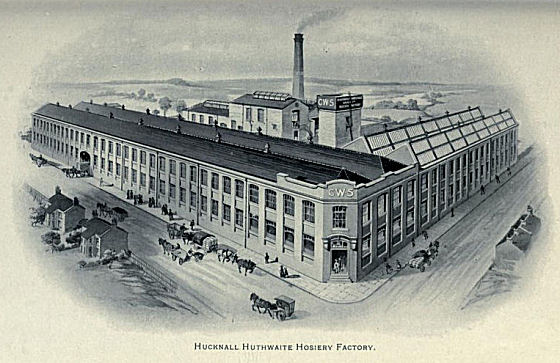A Hucknall History
Industrial Developments
CWS Opens Manufacturing
Locally reporting a December 1907 opening for the Huthwaite hosiery factory would have publicised availability of forthcoming jobs. It suggests construction was complete enough to open doors inviting inspection, A key number of relocated Leicester staff could restart their installed machinery, but a few more weeks were apparently needed to locally employ and train up a full workforce.

Again without any known public ceremony, the Co-operative Wholesale Society historically asserted 4th February 1908 had been actual opening day for its new hosiery factory, based on full production commencing. And then they had to acknowledge it turned out to be yet another problematic start-up!
After making this huge investment, Huthwaite folk wouldn't be aware how this new factory was soon facing heavy losses. Nonetheless, sad outcome of realising customer complaints multiplied within the first few months of business, was an unforgivable fact relayed down several future generations.
Investigating cause behind this problem practically brought production to a standstill. The Committee were forced into making several bold decisions in order to ensure future success in manufacturing quality hosiery. Root of an unprofitable start placed some blame on carrying over a very large stock of unsold goods. They proved difficult to sell before depreciated further by an unexpected fall in yarn prices. Adding upheaval of relocating and setting up new works was an excuse claimed to have furthermore pressured management into continually allowing unchecked production of inferior garments.
Figures presented to the board chairman at the first general meeting had been described by one delegate "as the worst balance sheet on the productive side ever placed before them." Nonetheless, actual amounts did prove insignificant in hands of good accountants. By restricting purchasing while selling off lower priced goods, they rebalanced the stock levels to allow a totally fresh financial start under a newly appointed manager. 
November 1908 could thus be loosely considered yet another opening date. That's when Mr H France successfully took over managers position leading this CWS factory into producing quality hosiery. No doubt ably assisted, its still a remarkable turnaround to present a productive 1908 year profit. From £53,000 to over £80,000, came less surprising annual leaps from £85,000 into £107,000, and £127,000 for 1912. This Huthwaite hosiery factory was still in its infancy, so its interesting to note the CWS eventually grew into an equal if not larger village employer than the primary New Hucknall Colliery.

Around 400 workers had initially been needed just to start factory production. Number was slightly above the maximum previously employed in their past Leicester premises. About an eighth of those accepted CWS invitation to relocate their work here, while there was little difficulty locally recruiting vast remainder, because the previous lack of suitable jobs especially for young women had been main reason behind enticing this new secondary industry.
District renown for manufacturing fine hosiery had already been established. Although there's little comparison between modern factory production lines with a past home based cottage industry of stockingers operating antiquated wooden framework knitters by hand, being in charge larger machinery remained entrusted only to highly skilled male operatives.
Females performed majority of simpler nimble tasks piecing together finished garments. Described to be often "so simple that any normal girl can learn it in a short time ..." suggests a repetitive monotony. Such thinking could have, however, devalued the time served skill at being able to do jobs both well and very quickly. Quality control did prove an initial problem. So attention to detail was given second time around ensuring all received adequate training, also keeping manufacturing methods closely guarded.
When God himself forbid any unmarried mothers, there was another unbreakable company rule remembered by all former workers. Woman who'd accepted marriage then had to unquestionably leave the CWS factory. This rule was actually positively seen to keep reopening jobs. They always showed hiring preference from an endless queue of eager young girls straight from leaving school.
Employee numbers had noticeably risen to 612 by October 1913. Asserting years for three major extensions accommodated vast expansion towards ultimately employing upwards 1,500.
23 Jul 14 by Gary Elliott Updated 05 Oct 23
